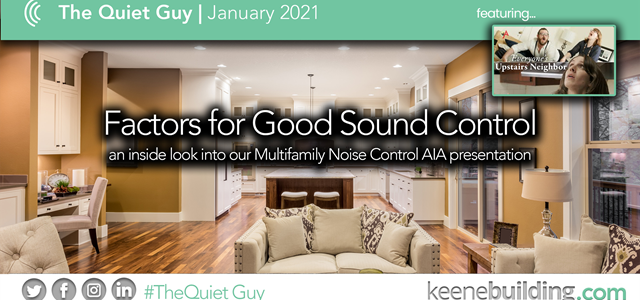
Common complaints in an apartments include footfall, dragging noises, laundry noises, and more. This week, The Quiet Guy dives into The Factors for Good Sound Control.
This week we are diving into a 15 min. video clip from our Multifamily Noise Control AIA presentation. You can watch the video or read the transcript! You decide.
WATCH THE VIDEO HERE: https://youtu.be/ZznJeA-Gv-g
We really want to understand how the inadequacies of a particular floor ceiling assembly can affect the noise control. Basically, we want to incorporate recent developments that have been made to dramatically improve the assemblies for a healthier living environment for the tenants and occupants of the spaces.
Watch this video to understand common coplaints in Multifamily construction: https://youtu.be/xHxMFNqpxrg
Measurements of Noise
There are the two different criteria or ASTM standards that we utilize for noise control STC & IIC.
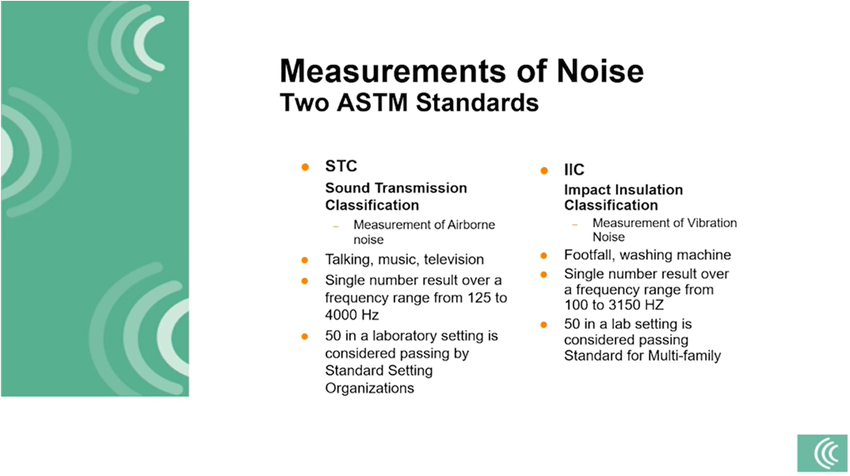
STC will measure airborne noise, which is comprised of voices, music, people talking, television and that is based on a single number. We measure that on a frequency range from 125 hertz to 4000 Hz. Keep in mind that this is done on a logarithmic scale, meaning that the higher you go the more effective the noise control, by a certain multiple. Therefore, going from a 50 to a 55 rating, is not quite as effective as a 55 to a 60. Going from a 55 to a 60 compared to 50 to 55 is anywhere from 10 to 20 times greater in terms of effectiveness. In a laboratory test, we shoot for 45. That means we get five points of grace; since in a real situation there are ceiling penetrations. In a lab test we do not test with penetrations through the ceiling (ie: sprinklers, smoke detectors, light fixtures, hvac vents, etc.)
The other type of noise that we measure is the one that is the most important, IIC, which stands for Impact Insulation Class. IIC measures the amount of vibration noise passing through due to footfall, dragging things across the floor, a washing machine or dryer, anything that's going to produce a vibration through the floor ceiling assembly. Again, we do measure that in a single number result. This time we go down to 100 hertz and only up to 3150. Most of the testing that we do here at Keene now, is measured down to 30 and 50 hertz because we really want to try to capture how effective our products are doing in very low frequency thud noises. These types of noises are the single biggest complaints in multi-family wood frame construction. A rating of 50 in a lab is considered passing for multifamily building code, again we need to match a 45 for a field test.
5 Factors for Good Sound Control
This image shows the factors and opportunities for good sound control, which utilize decoupling and isolation. This is based on how we best decouple and isolated the assembly and create what we call the mass spring mass. When we look at a floor ceiling assembly, in wood construction, we typically see five different opportunities to create mass spring mass.
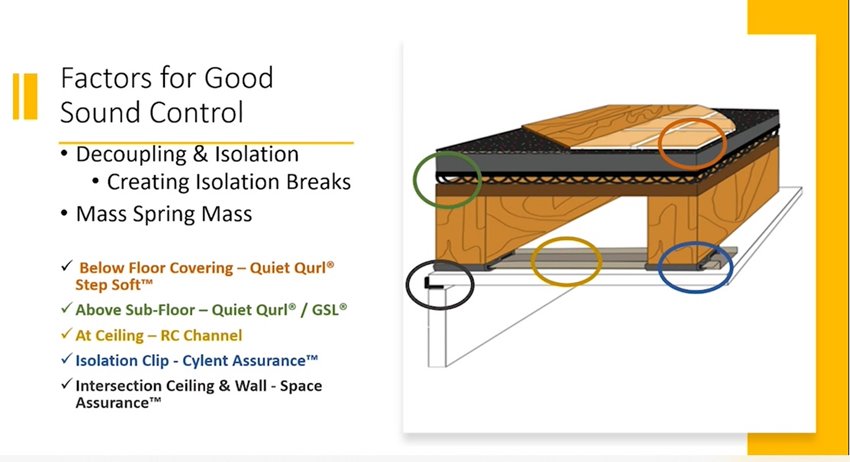
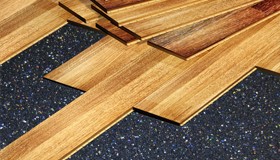
The first one, from starting on the top of the assembly, which is where we have the floor covering. This could be a ceramic tile, vinyl tile, an engineered wood or LVT to look like engineered wood. We can create an isolation break with a rubber sound mat that we call Quiet Qurl Step Soft (pictured). It is a topically added mat underneath the floor covering and is on top of three-quarter inch, or one and a half inch lightweight or gypsum concrete. So, we have created mass in the floorcovering, spring in the rubber type of topical mat, mass in the lightweight or gypsum concrete.
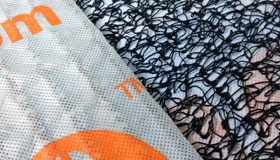 Second opportunity for mass spring mass is above the floor deck itself. Here, there is typical three-quarter inch gypsum concrete over an entangled net sound mat, then a three-quarter inch plywood deck. So again, mass spring mass.
Second opportunity for mass spring mass is above the floor deck itself. Here, there is typical three-quarter inch gypsum concrete over an entangled net sound mat, then a three-quarter inch plywood deck. So again, mass spring mass.
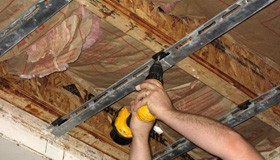 The third place we create mass, spring mass is on the ceiling side, where we put in a RC type of channel, and typically for the RC channel I always recommend Clarke Dietrich RC 1 Deluxe, since we get the maximum IIC rating out of that channel compared to a generic RC channel. Generic channels wind up being used on project, as they are much cheaper than an RC Deluxe. But all the sound testing that's done by any manufacturer that manufactures gypsum concrete and or sound mat, always utilize RC Deluxe, as it will have five-to-six-point higher IIC rating than a generic channel.
The third place we create mass, spring mass is on the ceiling side, where we put in a RC type of channel, and typically for the RC channel I always recommend Clarke Dietrich RC 1 Deluxe, since we get the maximum IIC rating out of that channel compared to a generic RC channel. Generic channels wind up being used on project, as they are much cheaper than an RC Deluxe. But all the sound testing that's done by any manufacturer that manufactures gypsum concrete and or sound mat, always utilize RC Deluxe, as it will have five-to-six-point higher IIC rating than a generic channel.
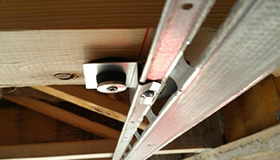 The fourth place for mass, spring mass is with an isolation clip. Adding an isolation clip can help add to the IIC value the assembly. At Keene, we have introduced a patented clip called the Cylent Assurance Clip. This clip far exceeds all other isolation clips on the market today and can get a wood frame floor ceiling assembly IIC results in the low to mid 60’s!
The fourth place for mass, spring mass is with an isolation clip. Adding an isolation clip can help add to the IIC value the assembly. At Keene, we have introduced a patented clip called the Cylent Assurance Clip. This clip far exceeds all other isolation clips on the market today and can get a wood frame floor ceiling assembly IIC results in the low to mid 60’s!
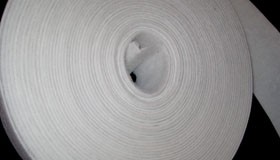 Lastly, we want to look at the ceiling line, indicated by the little black "L" in our graphic, which represents the eighth inch gap that is required., at the ceiling line. The specs are proper for acoustics, when it calls out for an eighth inch gap between the vertical wall and the horizontal ceiling. The reason for that is to eliminate the connection point and an opportunity to decoupling the connection between construction components. We do not want these two pieces of drywall the come into contact, otherwise, it will transfer vibration noise through the ceiling and down through the walls into the space below. This gap is typically called out as an eighth inch gap to be maintained and then acoustically caulked. At Keene we happen to have a product called Space Assurance that forces a piece of fabric between these two layers of drywall and ensures that gap. Typically, walls are not square, so along this ceiling line it is inevitable that the ceiling and wall will touch. Therefore, it is very difficult for the drywall installers to maintain that eighth inch gap. Keene’s Space Assurance assures that you maintain that eighth inch gap.
Lastly, we want to look at the ceiling line, indicated by the little black "L" in our graphic, which represents the eighth inch gap that is required., at the ceiling line. The specs are proper for acoustics, when it calls out for an eighth inch gap between the vertical wall and the horizontal ceiling. The reason for that is to eliminate the connection point and an opportunity to decoupling the connection between construction components. We do not want these two pieces of drywall the come into contact, otherwise, it will transfer vibration noise through the ceiling and down through the walls into the space below. This gap is typically called out as an eighth inch gap to be maintained and then acoustically caulked. At Keene we happen to have a product called Space Assurance that forces a piece of fabric between these two layers of drywall and ensures that gap. Typically, walls are not square, so along this ceiling line it is inevitable that the ceiling and wall will touch. Therefore, it is very difficult for the drywall installers to maintain that eighth inch gap. Keene’s Space Assurance assures that you maintain that eighth inch gap. 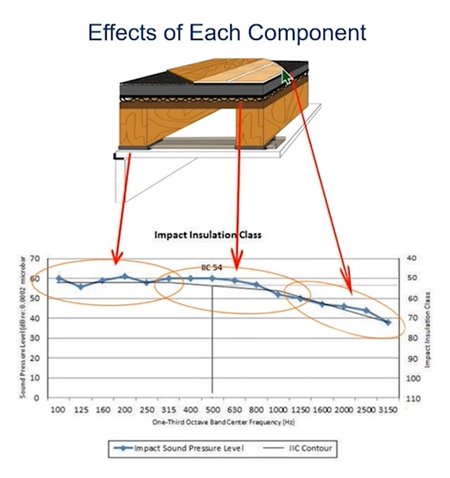
I like to refer to this graphic, as it really demonstrates where different components in an assembly can affect different areas and different types of frequency noise coming through the assembly. When we talk about topically added mat. which typically gets valued engineered out of the system, those type of products are excellent on the high frequency side, from 1,250 Hz to 3,150 Hz. High frequency noise is that “pinging” noise, often associated with clicking noise on a solid surface, like a high heel on a ceramic tile surface. When we get into the actual mid-range noises, from say 250 Hz out to 1000 Hz, is where the gypsum concrete and entanglement sound mats do a great job with mid-frequency noise control. I know that there are a lot of times I talked to several people that say "hey, I want to be able to get rid of the gypsum and the sound mat on the top side of the floor ceiling assembly”. They would rather use an isolation clip and justify that cost by eliminating the gypsum and sound mat. My response, that is great, but you are really going to be missing out on the mid-range frequency noise control, therefore your system will be allowing mid-frequency impact noise through the system. On the bottom side of the assembly is where you really can create some value with reducing low frequency noise, which is the biggest complaint, the thuds. These low frequency noises are controlled with the RC channel and channel isolation clips.
So, this graph is a good one in demonstrating good effective use of good components and a floor ceiling assembly because in combination, these materials all give us great noise attenuation noise control on the impact side in a floor ceiling assembly. This graph is a good one in demonstrating the effective use of good components in a floor ceiling assembly. The combination of these materials creates significant impact noise control in a floor ceiling assembly.
Let us talk about advent of the entangled net sound mats. Initially, these products came into vogue, in the late 80s and early 90s, because of getting away from carpet and pad as finished flooring. Entangled net sounds mats were first introduced in kitchens and baths only. That is where we were using mostly thinner floor covering like sheet vinyl and vinyl tile., By the early 90’s, people really wanted a fresh look on the floor, like ceramic or hardwood. So, entangled net systems really got their start just with kitchen and bathrooms. Eventually, that trend got to the whole unit, as people started falling in love with the look of hardwood, with LVL and LVT. This became a big challenge for impact noise. Enter entangled net systems as the solution to the thin floor covering problems and impact sound.
What are the Qualities of a good sound mat?
- Void – vibration travels through contact and the more contact, the greater ability for vibration noise to pass through a material.
- Resilience – The spring effect of an entangled net plastic, absorbs the vibration noise, so the greater the resilience the greater the vibration dampening.
- Airspace – The thicker the “spring” or sound mat, the greater wave size is filtered in the system. Airspace allows for pressure relief and heat buildup from impact sound to be effective.
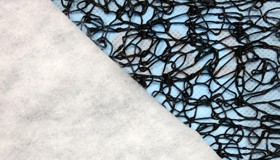 Typical entangled net is comprised of 95% air. It is comprised of a polymer core, meaning that it is made from polypropylene and recycled plastics. It is hydrophobic, meaning it does not gain or release moisture. So, it is really a neutral moisture component. It is made of a resilient structure. Again, it creates that spring for design in multifamily construction that we are looking for. They are thick enough to provide code compliance for STC and IC for all diverse types of floor coverings and all different type of joist and framing systems in wood frame. Keep in mind it takes a combination of good components to create an effective system. No single component can create a good sound attenuation system. It takes a combination of many materials to create a noise control system to meet expectations.
Typical entangled net is comprised of 95% air. It is comprised of a polymer core, meaning that it is made from polypropylene and recycled plastics. It is hydrophobic, meaning it does not gain or release moisture. So, it is really a neutral moisture component. It is made of a resilient structure. Again, it creates that spring for design in multifamily construction that we are looking for. They are thick enough to provide code compliance for STC and IC for all diverse types of floor coverings and all different type of joist and framing systems in wood frame. Keep in mind it takes a combination of good components to create an effective system. No single component can create a good sound attenuation system. It takes a combination of many materials to create a noise control system to meet expectations.

Here is all my contact information. Please feel free to connect me at any time; we appreciate everyone's attendance.
CONTACT KEENE